14 Philodendron Types with Pictures and Care Guide
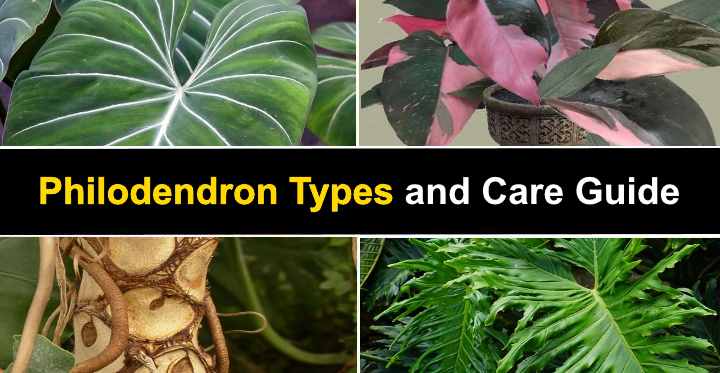
Philodendron plants are tropical flowering plants in the family Araceae. Many of the 480 species of Philodendron plants are popular houseplants thanks to their large, green leaves. Many indoor varieties of Philodendron plants are climbing vines that look stunning in hanging baskets. Other Philodendron types grow upright and have large split or deeply-lobed leaves. Whatever your interior décor, there is a type of Philodendron to suit your taste.
The most popular philodendron types: Common Philodendron plants are the heartleaf Philodendron with its long trailing foliage, the velvet-leaf plant, the Brasil Philodendron cultivar, and the stunning Pink Princess. The Philodendron White Knight is one of the rarest philodendrons with dark green and white variegated leaves.
How to care for philodendron plants: Grow Philodendron plants in well-draining soil, a bright indoor location, and water whenever the top 1” (2.5 cm) of soil is dry. These tropical plants thrive in high humidity and temperatures between 65°F and 80°F (18°C – 27°C). Fertilize once a month during the growing season and prune in the spring.
Upright Philodendrons vs. Climbing or Hanging Philodendrons (Philodendron Vine)
Depending on your interior décor, you can choose between a hanging (vining) Philodendron or an upright Philodendron variety.
Most climbing or hanging Philodendrons have heart-shaped leaves and long trailing vines. You can hang the vining plants in a basket from the ceiling or place on a high shelf for the beautiful long stems to create an attractive vertical accent. Some types of vining plants in the Philodendron family are the variegated Philodendron ‘Brasil’, ‘pink princess’ and the green heartleaf Philodendron.
Upright Philodendron plants usually have large, split leaves. Sometimes the green leaves can be so huge that they need some support. Compared to climbing Philodendrons, the upright species are slow-growing. Some varieties of upright Philodendrons include the Xanadu and the Green Congo Philodendron.
Types of Philodendrons (With Pictures and Common Names)
Let’s look in more detail at the various types of Philodendron plants that are suitable for homes, offices, and other indoor spaces. Along with the plant descriptions and pictures, scientific names will help identify each species of Philodendron.
Green Heartleaf Philodendron (Philodendron hederaceum)
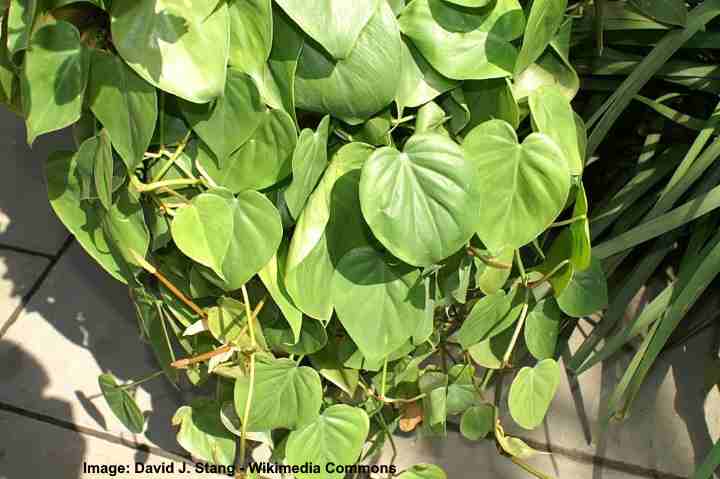
The Philodendron hederaceum is also named ‘sweetheart plant’ and ‘Heartleaf Philodendron’ because of its heart shaped leaves
The green heartleaf Philodendron is a vining type of plant with dark-green leaves in a heart’s shape. This type of Philodendron can be grown as a hanging plant or climbing plant. This specific species of Philodendron prefers shaded areas or low light conditions. Because they love humidity, green heartleaf Philodendron are excellent plants for bathrooms.
Another name for this Philodendron is sweetheart plant, and it is also botanically known as Philodendron scandens. The long trailing stems can reach lengths of between 10 and 20 ft. (3 – 6 m). The large leaves on the Philodendron may be as long as 1 ft. (30 cm). However, many houseplant varieties have heart-shaped leaves that are much smaller.
Philodendron Brasil (Philodendron Hederaceum ‘Brasil’)
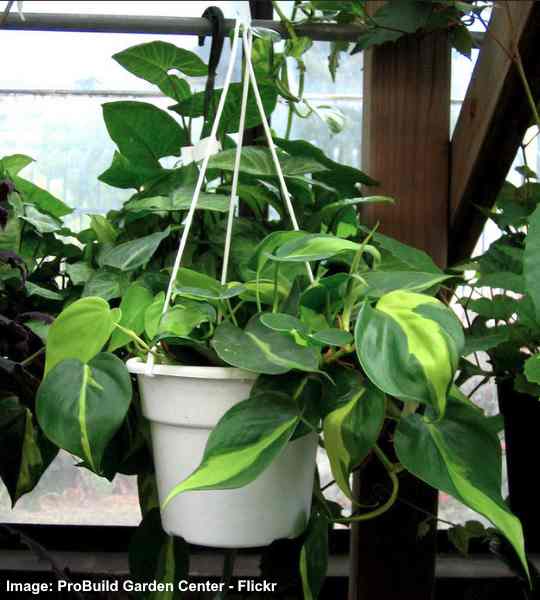
‘Brasil’ cultivar is a type of variegated heartleaf Philodendron. Image: Flickr
Philodendron Brasil is a variegated type of Philodendron which is a cultivar of the heartleaf Philodendron. This fast growing vining Philodendron has variegated heart shaped leaves that have lemon and lime green colors. Its brightly-colored leaves contrast with the pinkish-green stems to create an unusual hanging basket houseplant. This species of Philodendron is related to the heartleaf plant and has leaves of a similar shape.
Although the Philodendron ‘Brasil’ can tolerate low to medium light, bright light helps keep its foliage vibrant. This vining plant is extremely easy to grow and only requires occasional watering when the soil is partly dry. You can prune this climbing plant to encourage bushy growth and prevent floppy, leggy plant growth.
Some rare types of Philodendron ‘Brasil’ have yellow, green, and creamy-white variegation. These cultivars are called “cream splash Philodendron” and are difficult to find, even online.
Philodendron Micans (Philodendron Hederaceum Micans)
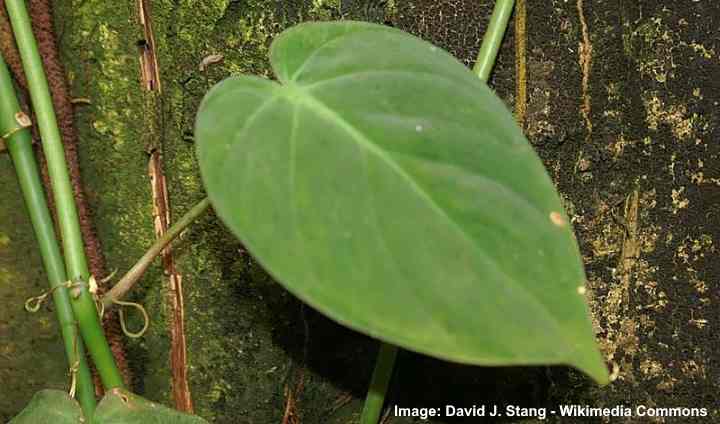
The heart shaped leaves of philodendron Micans have a velvety feel
Also called the velvet-leaf Philodendron, the ‘Micans’ plant is a trailing vine with heart-shaped leaves. As its name suggests, the leaves have a velvety texture with stunning iridescent foliage. Depending on how the light shines on the leaves, the Philodendron plant can look dark green, light green, or bronze. When new leaves grow, the leaves can be a pinkish-purple color.
To get the best out of the ‘Micans’ plant, grow in a hanging basket in bright, indirect sunlight. Ideally, the sunlight should never shine directly on the foliage. If the hanging Philodendron plant doesn’t get enough light, you may notice that the trailing vines become leggy with sparse foliage growth.
Philodendron Xanadu (Philodendron bipinnatifidum)

The Xanadu cultivar is an upright non-climbing philodendron type with split leaves
One of the best examples of an upright, non-climbing, indoor type of Philodendron is the Xanadu cultivar. This large leaf Philodendron has split leaves with deep lobes. Also called the Winterbourn, the cultivar grows in dense clumps. The tree-like Philodendron can grow up to 3 ft. (1 m) and have a spread of around 6 ft. (2 m) outdoors. As a tropical indoor plant, the growth is restricted to the size of the pot. Unlike fast-growing Philodendron climbers, this upright variety grows slowly.
This indoor plant is an excellent specimen evergreen leafy plant. Place the Xanadu plant in a location with medium to bright light. Its mounded shape means that it’s excellent as a floor plant or displaying on a planter. Its large glossy green lobed leaves capture attention as this large houseplant reflects light to brighten up a room.
Philodendron Pink Princess (Philodendron Erubescens)
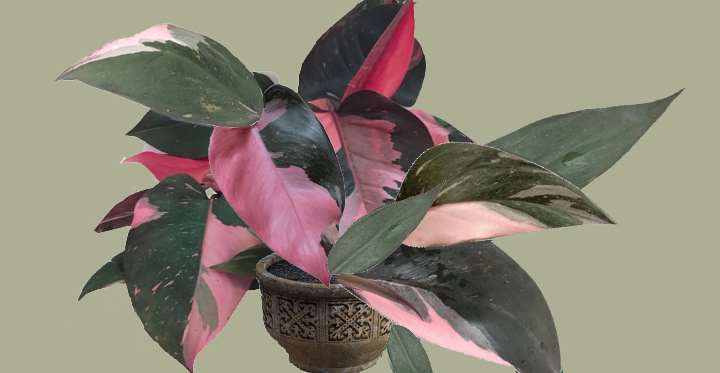
The Pink Princess hybrid is a type of Philodendron plant with green and pink variegated leaves
The Philodendron Pink Princess is a beautiful indoor plant with green and pink variegated leaves. Although this large-leafed exotic looking type of Philodendron is a vining plant, regular pruning can give it a bushy appearance. The features of this ‘pink’ plant are red stems and beautiful heart-shaped leaves. This fast-growing houseplant also has reddish colors on the underside of the leaves.
Although most Philodendron plants tolerate a wide range of conditions, the Pink Princess is fussier. This variety of Philodendron doesn’t tolerate cold as well as other plants. It needs bright, indirect sunlight to keep the leaves vibrant.
If you are looking to buy a pink Philodendron, be careful of the variety marketed as ‘Pink Congo.’ This type of houseplant has artificially-colored pink leaves that will turn back to dark green in about six months. However, the true ‘Pink Princess’ has natural leaf variegation that will last as long as the plant does.
Lacy Tree Philodendron (Philodendron selloum)
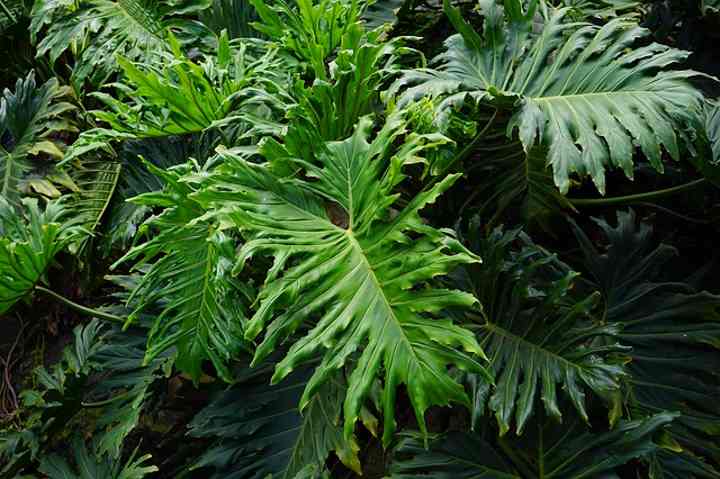
The large upright Lacy Tree Philodendron (Philodendron Selloum) is a type of Philodendron with big deeply lobed leaves
The lacy tree Philodendron looks similar to the Xanadu plant—and there’s a good reason for that. Both species of Philodendron are from the same species—P. selloum or P. bipinnatifidum. The difference between the two is that the Xanadu plant is a specific cultivar of this species. The lacy tree Philodendron also has deeply lobed leaves that are large, shiny, and waxy.
As the lacy tree Philodendron (Philodendron Selloum) grows and matures, its leaves become huge and start drooping. You’ll need a lot of room if you want to grow this upright Philodendron plant as it can grow up to 3 ft. (1 m) tall and 6 ft. (2 m) wide.
The big lacy tree Philodendron is also called lacy leaf Philodendron, split-leaf Philodendron, Horsehead Philodendron, Cut-Leaf Philodendron, or Fiddle-leaf Philodendron.
Naugahyde Philodendron (Rugosum Philodendron)
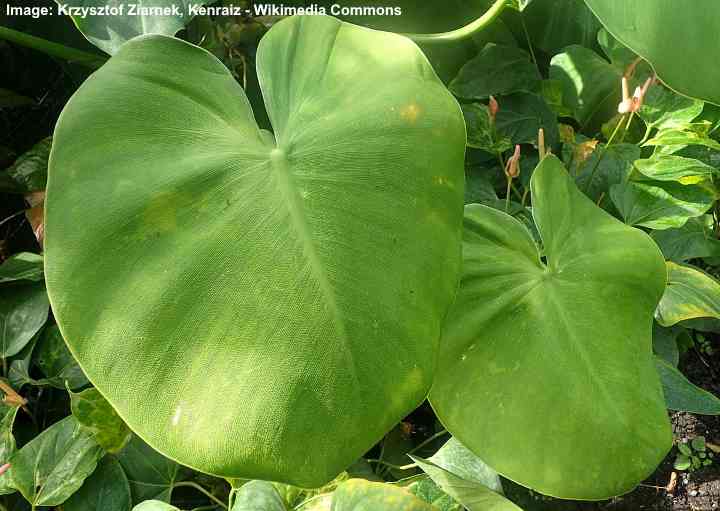
Rugosum Philodendron has huge heart shaped leaves
The Naugahyde type of Philodendron is also called the pigskin plant due to its thick leathery leaves. Looking closely at pictures of this Philodendron, you’ll notice intricate patterns on the dark green heart-shaped leaves. From a distance, the leathery look of the plant’s foliage makes it look like a plastic plant.
The distinguishing feature of this plant from the family Araceae is the exceptionally large leaves. It is rare to find this variety of Philodendron in garden centers or even online.
Blushing Philodendron (Philodendron erubescens)
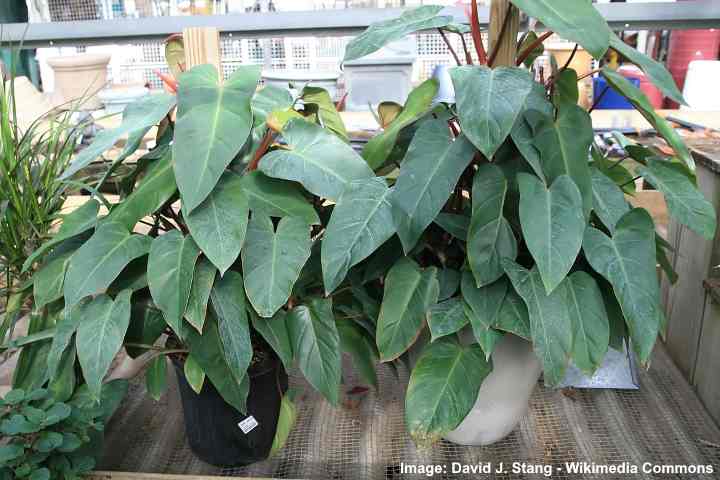
In the picture: Philodendron erubescens ‘Red Emerald’ which has red stems
The blushing Philodendron is a cultivar from the same species as the ‘Pink Princess’ plant. This type of Philodendron plant features delightful glossy dark green foliage in the shape of an arrowhead or elongated heart. The name ‘blushing’ comes from the reddish-purple underside of the large Philodendron leaves. Another name for this stout, evergreen climber, is the red-leaf Philodendron.
These large-leafed Philodendrons grow well in hanging baskets or as a climbing plant. The long trailing stems with large eye-catching leaves help to add height and greenery to any kind of room.
Philodendron ‘Moonlight’
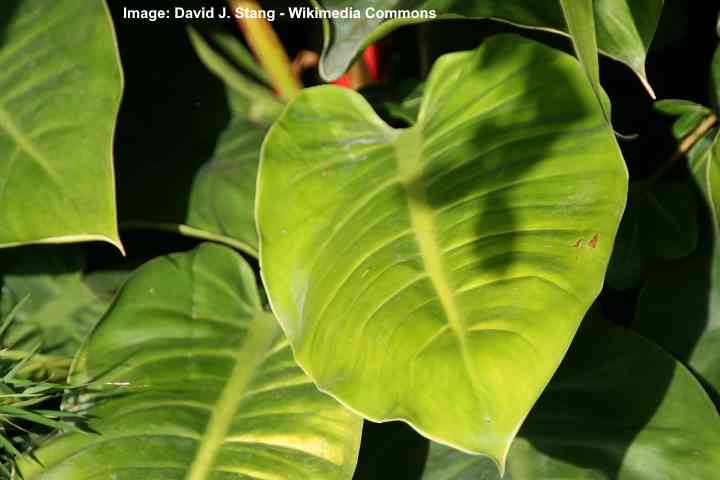
‘Moonligh’ cultivar has lime green leaves and is non climbing type of philodendron
This hybrid plant, the Philodendron Moonlight, is a non-vining, clump-forming plant that has bright, lime-green leaves. The fluorescent green foliage can brighten up any shaded corner of a room. New leaves grow as sunny-yellow leaves that gradually darken as they age. However, compared to other varieties of Philodendron, this cultivar is a bright-looking plant.
The best place to grow a Philodendron moonlight indoors is on a bright windowsill that is shaded from the sun. So, an east- or west-facing windowsill would be ideal. The Philodendron will grow in low-light environments, but the vibrancy of its leaves may fade.
Philodendron ‘Congo Rojo’
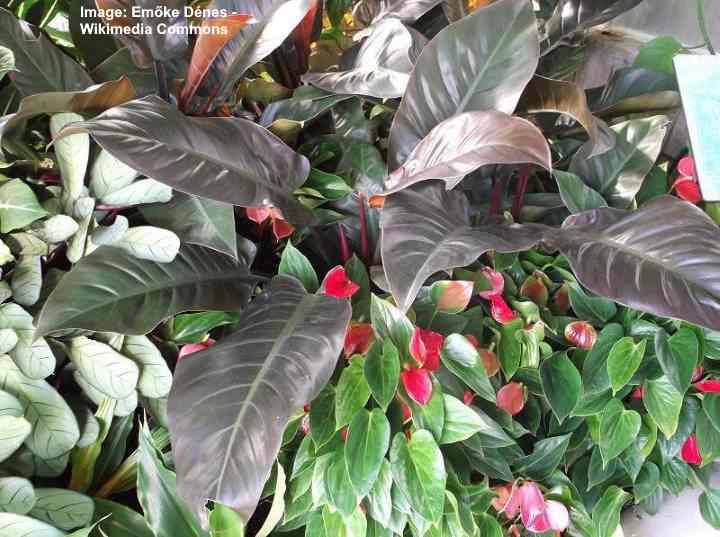
Philodendron ‘Congo Rojo’ has purple, burgundy and dark green foliage
The Philodendron ‘Congo Rojo’ is a large-leafed plant that has elongated oval-shaped leaves in various shades of red, burgundy, and dark green. This is a new type of Philodendron cultivar that thrives in warm environments. If you live in temperate climates, you can only grow this plant indoors. The ‘Congo Rojo’ only grows in tropical and subtropical climates outdoors.
Although this is not a rare variety of Philodendron, it’s not easy to find it in garden centers. The clumping plant doesn’t grow long trailing vines. Instead, the stiff burgundy stems grow large leaves that give this Philodendron a bushy, shrub-like appearance.
Philodendron Grazielae
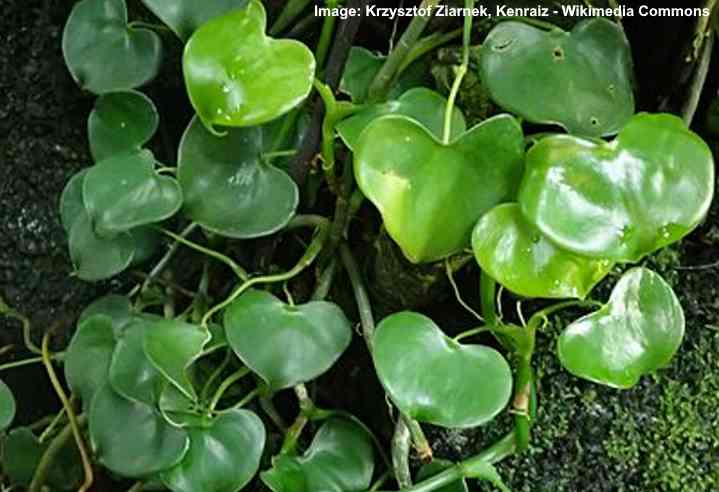
Philodendron Grazielae has long trailing vines that are suitable for hanging basket or climbing up a moss pole
The Philodendron grazielae is one of the most intriguing of all the Philodendron species. The vining plant has thick stems with small heart-shaped leaves that have glossy appearance. You can grow this Philodendron in containers and prune it regularly to maintain a bushy shape. Or, you can put it in a hanging basket and let the shiny green leaves brighten up a dull corner of a room or office.
Philodendron Prince of Orange

Philodendron Prince of Orange gets its name from its orange-colored new leaves
Another of the interesting Philodendron cultivars is the ‘Prince of Orange.’ This Philodendron plant gets its name from the large coppery-orange leaves that emerge from it. As the leaves mature, they gradually turn to darker shades of green. This color combination gives the plant a stunning appearance with large pointed leaves of different shades growing together.
The best place to grow a Prince of Orange Philodendron is in a bright spot, away from direct sunlight. This Philodendron cultivar is an upright, non-climbing, plant that can reach an upright height of 2 ft. (60 cm).
Philodendron Gloriosum
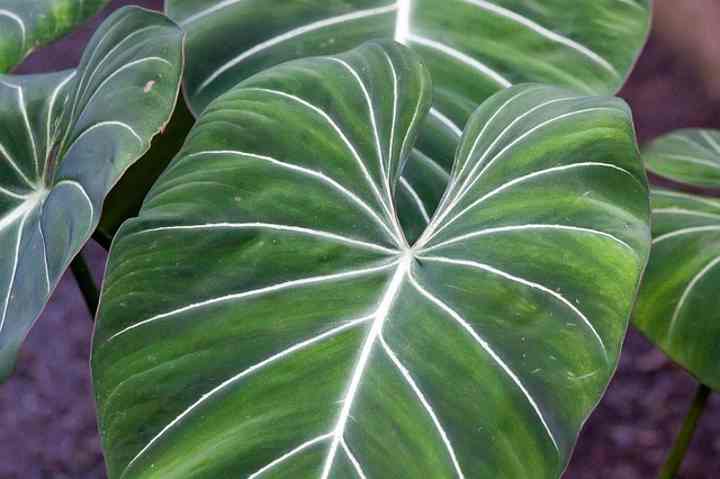
Philodendron gloriosum has large velvety green leaves with white or pinkish veins
The Philodendron gloriosum is a species of plant with spectacular dark green leaves and white veins. The large heart-shaped leaves on this crawling variety of Philodendron are a deep green color with pinkish margins, and pale green, white, or pinkish veins.
If you want to grow this type of Philodendron indoors, you’ll need to have plenty of space. The velvety green heart-shaped leaves can grow up to 3 ft. (90 cm) high. The thick woody stems seem to arch in different directions, giving the plant a unique appearance. The plant grows best in shaded areas or partial shade. As with all Philodendron plants, keep the soil moist and don’t overwater.
Philodendron Birkin
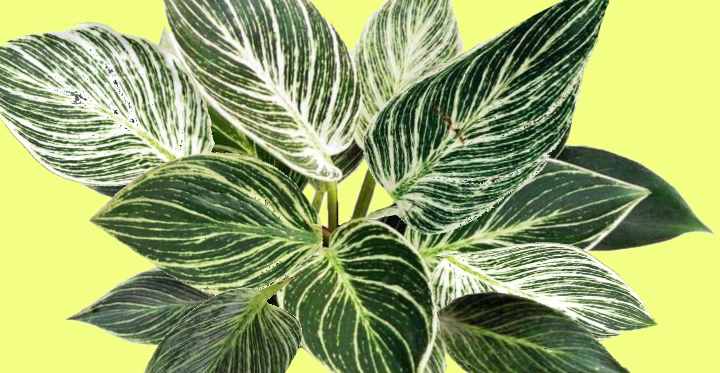
Philodendron Birkin is variegated philodendron with delicate creamy-white pinstripes
The Philodendron Birkin is a stunning variegated type of philodendron with leathery dark glossy leaves. Philodendron Birkin has heart-shaped leaves with delicate creamy-white pinstripes. The rare type of variegation changes from leaf to leaf and can even change color.
To care for Philodendron Birkin, grow the compact houseplant in indirect sun, fertile well-draining potting mix, and relatively high humidity. The ideal temperature range for growing the Birkin plant is between 60°F and 75°F (18°C – 24°C).
Philodendron Birkin is a relatively fast-growing houseplant with upward growth. A mature Birkin plant will take a few years to reach its maximum height of around 3 ft. (1 m).
How to Care for Philodendrons
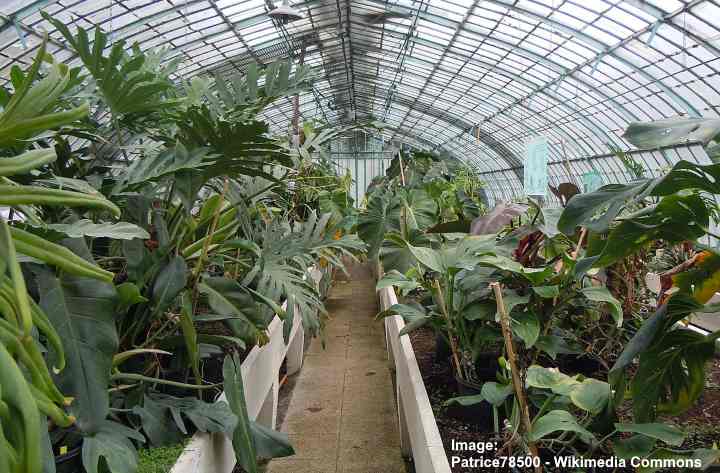
Various types of Philodendron plants in a greenhouse
From all of the varieties of houseplants to choose from, Philodendron plants are some of the easiest to look after. Many varieties are plants that are suitable for low-light conditions where there is high humidity—for example, in bathrooms. Other species of Philodendron need brighter light but protected from direct sunlight.
Light requirements for growing Philodendrons
All types of Philodendron plants thrive in medium to bright light. The most important care requirement is to protect them from direct sunlight. The darker-leafed species of Philodendron are suitable for shaded areas. However, variegated Philodendron plants need bright, filtered light.
Soil mix for philodendrons in pots
Grow Philodendron plants in a potting mix that has excellent drainage, but still holds some moisture. A potting mixture of peat moss, perlite, and potting soil should create the perfect medium for Philodendron plants to thrive indoors. Water should easily drain out the pot’s drainage holes. However, the soil needs to stay moist between watering.
How to water a Philodendron indoor plant
Water any type of Philodendron when the top layer of soil has dried out. Always water your green, leafy plant by thoroughly soaking or drenching the soil. This deep watering technique allows the roots to stay constantly moist without becoming waterlogged. Waiting until the soil partly dries also helps to prevent problems with fungus gnats.
Temperature and humidity for indoor philodendrons
Coming from subtropical and tropical regions, Philodendron plants need high levels of humidity. To care for your plant properly, mist the leaves daily or place the plant pot on a humidifying tray. Average room temperatures are perfect for growing Philodendrons, so keep even temperatures of between 65°F and 80°F (18°C – 27°C).
How to fertilize philodendrons
The best type of fertilizer for indoor Philodendron plants is a balanced liquid fertilizer with micro and macro nutrients. Fertilize your Philodendron plants once a month during the growing season—spring and summer. Stop fertilizing during fall and winter when growth slows down.
Find more information about the best fertilizers for Philodendron in our article about the best fertilizers for indoor plants.
Related articles:
- The Best Indoor Vine Plants and Climbers
- Tall and Large Indoor Plants for Homes and Offices
- How Often and How Much to Water Houseplants
